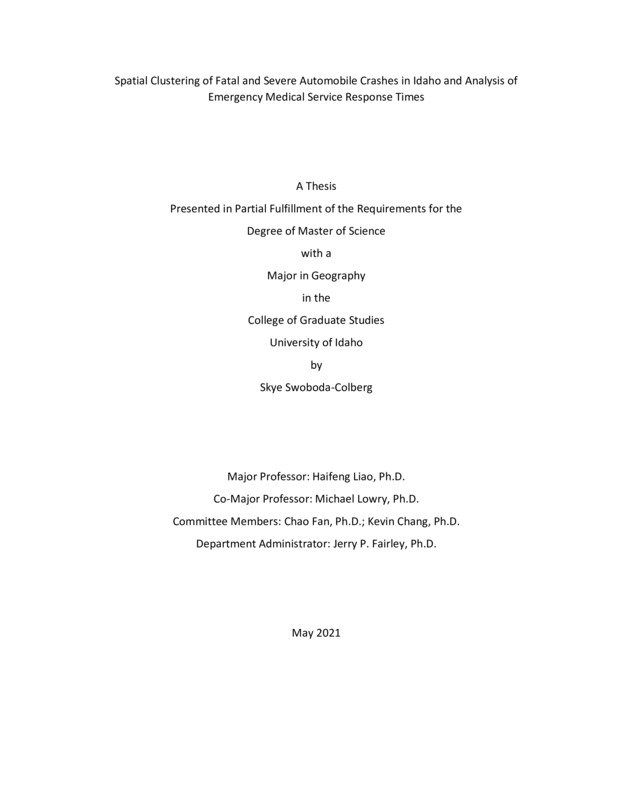Spatial Clustering of Fatal and Severe Automobile Crashes in Idaho and Analysis of Emergency Medical Service Response Times
Swoboda-Colberg, Skye. (2021-05). Spatial Clustering of Fatal and Severe Automobile Crashes in Idaho and Analysis of Emergency Medical Service Response Times. Theses and Dissertations Collection, University of Idaho Library Digital Collections. https://www.lib.uidaho.edu/digital/etd/items/swobodacolberg_idaho_0089n_12107.html
- Title:
- Spatial Clustering of Fatal and Severe Automobile Crashes in Idaho and Analysis of Emergency Medical Service Response Times
- Author:
- Swoboda-Colberg, Skye
- Date:
- 2021-05
- Keywords:
- Clustering Crash EMS Idaho Response Time
- Program:
- Geography
- Subject Category:
- Geographic information science and geodesy; Geography
- Abstract:
-
Automobile crashes are a leading cause of death in the United States. The timely response of Emergency Medical Services (EMS) to these events is critical for the survival of crash victims. Drawing upon fatal and severe crash data in Idaho, this research aims to measure the Accessibility of EMS to fatal and severe crashes using actual and predicted temporal response intervals. Geographical approaches are utilized to identify statistically significant differences among these intervals between Urban, Rural, and Roadway classifications and identify areas that could benefit from a more rapid EMS response in Idaho. This study investigates the spatial clustering of Fatal and Severe crashes in Idaho over a 6-year period and analyzes the Emergency Medical Service Response times for those crashes.
Results demonstrate that while the number of crashes (49.7% and 50.3%) and the number of injuries (48.6% and 51.4%) were distributed relatively evenly between rural and urban areas, most fatalities occurred on rural roadways (76.0% and 24.0%). Both the Response Interval and Critical Interval in rural areas were more than double those in urban areas, with 72% of crashes on urban roadways in Idaho having a Critical Interval less than or equal to 8 minutes. In contrast, only 24% of crashes on rural roadways had a Critical Interval within this threshold. The results also show that the EMS response Interval is consistently underpredicted within the potential accessibility framework by 3.3 minutes in rural areas and 1.6 minutes in urban areas. Underprediction appears to be concentrated in areas adjacent to urban metropolitan regions.
- Description:
- masters, M.S., Geography -- University of Idaho - College of Graduate Studies, 2021-05
- Major Professor:
- Liao, Haifeng; Lowry, Michael
- Committee:
- Fan, Chao; Chang, Kevin
- Defense Date:
- 2021-05
- Identifier:
- SwobodaColberg_idaho_0089N_12107
- Type:
- Text
- Format Original:
- Format:
- application/pdf
- Rights:
- In Copyright - Educational Use Permitted. For more information, please contact University of Idaho Library Special Collections and Archives Department at libspec@uidaho.edu.
- Standardized Rights:
- http://rightsstatements.org/vocab/InC-EDU/1.0/

